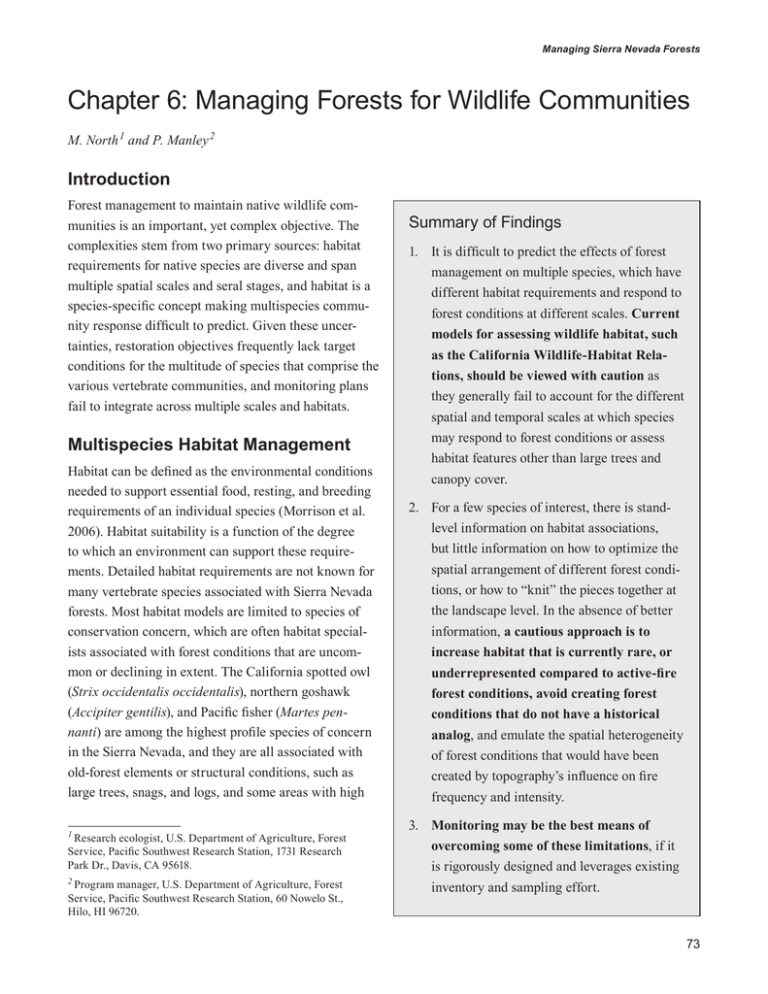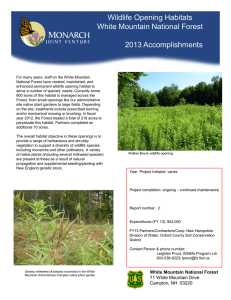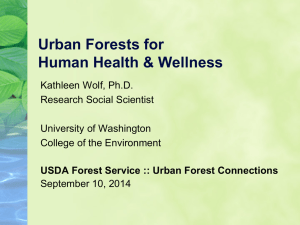Chapter 6: Managing Forests for Wildlife Communities Introduction Summary of Findings
advertisement

Managing Sierra Nevada Forests Chapter 6: Managing Forests for Wildlife Communities M. North 1 and P. Manley 2 Introduction Forest management to maintain native wildlife communities is an important, yet complex objective. The complexities stem from two primary sources: habitat requirements for native species are diverse and span multiple spatial scales and seral stages, and habitat is a species-specific concept making multispecies community response difficult to predict. Given these uncertainties, restoration objectives frequently lack target conditions for the multitude of species that comprise the various vertebrate communities, and monitoring plans fail to integrate across multiple scales and habitats. Multispecies Habitat Management Habitat can be defined as the environmental conditions needed to support essential food, resting, and breeding requirements of an individual species (Morrison et al. 2006). Habitat suitability is a function of the degree to which an environment can support these requirements. Detailed habitat requirements are not known for many vertebrate species associated with Sierra Nevada forests. Most habitat models are limited to species of conservation concern, which are often habitat specialists associated with forest conditions that are uncommon or declining in extent. The California spotted owl (Strix occidentalis occidentalis), northern goshawk (Accipiter gentilis), and Pacific fisher (Martes pennanti) are among the highest profile species of concern in the Sierra Nevada, and they are all associated with old-forest elements or structural conditions, such as large trees, snags, and logs, and some areas with high Research ecologist, U.S. Department of Agriculture, Forest Service, Pacific Southwest Research Station, 1731 Research Park Dr., Davis, CA 95618. 1 Program manager, U.S. Department of Agriculture, Forest Service, Pacific Southwest Research Station, 60 Nowelo St., Hilo, HI 96720. 2 Summary of Findings 1. It is difficult to predict the effects of forest management on multiple species, which have different habitat requirements and respond to forest conditions at different scales. Current models for assessing wildlife habitat, such as the California Wildlife-Habitat Relations, should be viewed with caution as they generally fail to account for the different spatial and temporal scales at which species may respond to forest conditions or assess habitat features other than large trees and canopy cover. 2. For a few species of interest, there is standlevel information on habitat associations, but little information on how to optimize the spatial arrangement of different forest conditions, or how to “knit” the pieces together at the landscape level. In the absence of better information, a cautious approach is to increase habitat that is currently rare, or underrepresented compared to active-fire forest conditions, avoid creating forest conditions that do not have a historical analog, and emulate the spatial heterogeneity of forest conditions that would have been created by topography’s influence on fire frequency and intensity. 3. Monitoring may be the best means of overcoming some of these limitations, if it is rigorously designed and leverages existing inventory and sampling effort. 73 GENERAL TECHNICAL REPORT PSW-GTR-237 Managers may examine what forest conditions currently are rare compared to historical active-fire conditions, and then treat stands to increase underrepresented habitat conditions canopy closure. To provide habitat for a broad array of species, managers will need to consider other seral conditions and forest structures. For example, some songbirds are strongly associated with shrub patches (Burnett et al. 2009) that have become increasingly rare in the low-light understory of fire-suppressed forests. In addition to old-forest conditions, some habitats (e.g., aspen stands, meadows, open large pine-dominated forests, shrub fields) and some “special habitat elements” (e.g., “defect” trees, downed logs, large snags) have clearly declined in abundance (Bouldin 1999). In the absence of better information, managers may examine what forest conditions currently are rare compared to historical active-fire conditions, and then treat stands to increase underrepresented habitat conditions. A second concern is that many wildlife species respond to forest conditions at multiple spatial and temporal scales. This suggests that management practices should be based on careful consideration of the amounts and configurations of current and target habitat conditions within landscapes. In many cases, however, potential management impacts on wildlife are examined only at the stand scale or over relatively short timeframes. Temporal considerations can be particularly important because decades of stand development may be needed to create some desired habitat conditions. Management plans should be explicit about maintaining current high-value habitat in sufficient amounts and distribution while at the same time treating other areas more heavily to accelerate development of desired future habitat conditions. For large-scale assessments of landscapes, it is often difficult to determine the optimal size and distribution of different forest conditions that would improve current and future habitat conditions for the local vertebrate community. There are few reference landscapes with active fire regimes, and the spatial configuration of habitat conditions in such landscapes has yet to be examined (fig. 6-1). While research can suggest general principles for landscape-scale wildlife management, such as providing for connectivity and a mosaic of forest conditions (Hilty et al. 2006, Lindenmayer and Fisher 2006, Lindenmayer et al. 2008), specifics are generally lacking and will differ with different species and existing forest conditions. Lacking better information, a prudent approach may be to emulate the variation in forest conditions that could be expected to occur given the influence of local topographic conditions on fire frequency and intensity (North et al. 2010). Vertebrate Conservation and Fuels Reduction Fuels reduction commonly focuses on reducing the amount and connectivity of woody material on the forest floor, from the forest floor to the canopy, and across the canopy. Two of the primary challenges associated with reducing the risk of high-intensity wildfire and maintaining native vertebrate species are (1) inadequate 74 Marc Meyer Managing Sierra Nevada Forests Figure 6-1—Illilouette Basin, Yosemite National Park, which has burned several times since being designated a wildland-fire use area in the 1970s. Note the diversity and complexity of different forest types and conditions resulting in part from different fire severity patterns and changes in edaphic conditions. tools for characterizing wildlife habitat relationships and assessing impacts of fuels treatments to these habitats, and (2) the inherent conflict between maintaining existing species while changing forest structure and composition. Currently, models for assessing how different types of treatments affect the wildlife community lack precision. The California Wildlife-Habitat Relationships (CWHR) database is often used to approximate how treatments will alter habitat based on general changes in tree size and canopy cover (Mayer and Laudenslayer 1988). The forest is broadly categorized using the dominant tree size class, and canopy cover is approximated through interpretation of aerial photographs or modeled indirectly with the Forest Vegetation Simulator into broad cover classes (see limitations of this approach in chapter 14 under “Canopy Cover and Closure”). These are rough estimates of a forest’s habitat taken at a fixed point in time and do not consider features such as snags, down wood, or understory diversity that are often linked to wildlife use. The CWHR is a set of broad-scale habitat associations and general life history traits for the 694 species in its database that is based largely on expert opinion. Consequently, the use of CWHR for making reliable, projectlevel predictions on the potential habitat impacts of forest management activities on a wildlife community is limited. In addition, CWHR does not account for area size and landscape context in its habitat designations (George and Zack 2001). Furthermore, tests of CWHR (Block et al. 1994, Laymon 1989, Laymon and Halterman 75 GENERAL TECHNICAL REPORT PSW-GTR-237 effectiveness of “keystone,” “umbrella,” “indicator,” “top predator,” and “flagship” species suggest that management activities that are based on such surrogate species generally fail to capture the needs of the ecosystem’s broader array of species. Figure 6-2—Example of a fuels treatment that removes all understory and ladder fuels, a condition sometimes referred to as a “clearcut from below.” 76 Pat Manley Assessments of the 1989, Purcell et al. 1992) have found high rates of omission (species detected but not listed in CWHR) and commission (species predicted but not present), prompting the authors of one study (Block et al. 1994) to suggest that CWHR not be used “as the sole source of information in land-use decisions.” Variation in forest community types (e.g., CALVEG) has also been used to estimate landscape-scale biodiversity, but research suggests it may fail to explain variation in species abundances or account for spatial variability (Cushman et al. 2008, Noon et al. 2003). For some sensitive wildlife species, quantitative models have been developed to examine how treatments may impact habitat quality more explicitly (e.g., Thompson et al. 2011). However, the use of such models to infer impacts on the entire vertebrate community should be viewed with caution. Recent assessments of the effectiveness of “keystone,” “umbrella,” “indicator,” “top predator,” and “flagship” species suggest that management activities that are based on such surrogate species generally fail to capture the needs of the ecosystem’s broader array of species (Caro 2010, Sergio et al. 2008). Fuels treatments alter habitat conditions for wildlife species that currently occupy the treatment area, benefiting some but reducing habitat quality for others (Stephens et al., in press). Managers should be cautious when applying prescriptions that result in the simplification and homogenization of stand structures, creating relatively novel habitat conditions to which few native vertebrate species are adapted. These include significantly reducing or eliminating crown overlap, vertical canopy complexity, and small tree and understory cover (fig. 6-2). Fuels reduction that removes all understory cover, sometimes called “clearcutting from below,” Managing Sierra Nevada Forests may eliminate habitat for many species of the vertebrate community. For example, a diverse array of understory shrubs may serve a variety of ecological functions including the provision of wildlife forage and protective cover, soil stabilization, nitrogen fixation, barriers to invasive plant establishment, and sources of nectar for pollinators. Yet because of their potential role as a fuel and their competition with tree seedlings, some treatments specifically strive to dramatically reduce or eliminate shrub cover. Eliminating these conditions probably moderately increases forest resistance to crown fire and may have value close to communities and in strategic locations. However models suggest retaining these stand features may not significantly increase high-severity fire risk if care is taken to create vertical diversity in vegetation cover without creating ladder fuels. An alternative approach in fuels reduction projects would be to manage for wildlife habitat heterogeneity: (1) increase the frequency of underrepresented habitat conditions (e.g., late-seral structures, canopy gaps, open, low-density forests, rare or uncommon tree and shrub species), (2) promote variable forest conditions based on natural topography and fire regimes, and (3) facilitate both overstory and understory vegetation diversity. Multiscale Monitoring Effective monitoring is needed to understand the complex response of wildlife communities to forest management. There is a perception that resources and expertise are too limited to initiate a multispecies, multiscale monitoring program. Manley et al. (2006), however, introduced a protocol to serve as a consistent and efficient method for obtaining basic presence/absence and habitat data for several species at sites using a probabilistic sample. The Multiple Species Inventory and Monitoring (MSIM) protocol is designed to be implemented in association with Forest Inventory and Analysis grid points. The protocol uses a base monitoring approach on which national forests can build to meet their specific monitoring needs with the greatest efficiency of effort and cost. The MSIM protocol could be used as a basis for developing plans to monitor treatments following U.S. Forest Service General Technical Report PSW-GTR 220 “An Ecosystem Management Strategy for Sierran Mixed-Conifer Forests” (North et al. 2009) concepts and to assess how management strategies may better meet desired conditions. 77 GENERAL TECHNICAL REPORT PSW-GTR-237 References Block, W.M.; Morrison, M.L.; Verner, J.; Manley, P.N. 1994. Assessing wildlife-habitat-relationships models: a case study with California oak woodlands. Wildlife Society Bulletin. 22: 549–561. Bouldin, J. 1999. Twentieth-century changes in forests of the Sierra Nevada, California. Davis, CA: University of California, Davis. 222 p. Ph.D. dissertation. Burnett, R.; Jongsomjit, D.; Stralberg, D. 2009. Avian monitoring in the Lassen and Plumas National Forest: 2008 annual report. Point Reyes Bird Observatory Contribution. 1684: 104–186. Caro, T. 2010. Conservation by proxy: indicator, umbrella, keystone, flagship, and other surrogate species. Washington, DC: Island Press. 374 p. Cushman, S.A.; McKelvey, K.S.; Flather, C.H.; McGarigal, K. 2008. Do forest community types provide a sufficient basis to evaluate biological diversity? Frontiers in Ecology and the Environment. 6: 13–17. George, T.L.; Zack, S. 2001. Spatial and temporal considerations in restoring habitat for wildlife. Restoration Ecology. 9: 272–279. Hilty, J.; Lidicker, W.Z., Jr.; Merenlender, A.; Dobson, A.P. 2006. Corridor ecology: the science and practice of linking landscapes for biodiversity conservation. Washington, DC: Island Press. 344 p. Laymon, S.A. 1989. A test of the California wildlife-habitat relationship system for breeding birds in valley-foothill riparian habitat. In: Abell, D.L., tech. coord. Proceedings of the California riparian systems conference: protection, management, and restoration for the 1990s. Gen. Tech. Rep. PSW-GTR-110. Berkeley, CA: U.S. Department of Agriculture, Forest Service, Pacific Southwest Forest and Range Experiment Station: 307–313. Laymon, S.A.; Halterman, M.D. 1989. A proposed habitat management plan for yellow-billed cuckoos in California. In: Abell, D.L., tech. coord. Proceedings of the California riparian systems conference: protection, management, and restoration for the 1990s. Gen. Tech. Rep. PSW-GTR-110. Berkeley, CA: U.S. Department of Agriculture, Forest Service, Pacific Southwest Forest and Range Experiment Station: 272–277. Lindenmayer, D.B.; Fischer, J. 2006. Landscape change and habitat fragmentation. Washington, DC: Island Press. 352 p. 78 Managing Sierra Nevada Forests Lindenmayer, D.; Hobbs, R.J.; Montague–Drake, R.; Alexandra, J., Bennett, A.; Burgman, M.; Cale, P.; Calhoun, A.; Cramer, V.; Cullen, P.; Driscoll, D.; Fahrig, L.; Fisher, J.; Franklin, J.; Haila, Y.; Hunter, M.; Gibbons, P.; Lake, S.; Luck, G.; MacGregor, C.; McIntyre, S.; Mac Nally, R.; Manning, A.; Miller, J.; Mooney, H.; Noss, R.; Possingham, H.; Saunders, D.; Schmiegelow, F.; Scott, M.; Simberloff, D.; Sisk, T.; Tabor, G.; Walker, B.; Wiens, J.; Woinarski, J.; Zavaleta, E. 2008. A checklist for ecological management of landscapes for conservation. Ecology Letters. 11: 78–91. Manley, P.N.; Van Horne, B.; Roth, J.K.; Zielinski, W.J.; McKenzie, M.M.; Weller, T.J.; Weckerly, F.W.; Vojta, C. 2006. Multiple species inventory and monitoring technical guide. Gen. Tech. Rep. WO-73. Washington, DC: U.S. Department of Agriculture, Forest Service, Washington Office. 204 p. Mayer, K.E.; Laudenslayer, W.F. 1988. Guide to wildlife habitats of California. Sacramento, CA: State of California, Resources Agency, Department of Fish and Game. 166 p. Morrison, M.; Marcot B.G.; Mannan, R.W. 2006. Wildlife-habitat relationships: concepts and applications. Washington, DC: Island Press. 435 p. Noon, B.; Murphy, D.; Beissinger, S.; Shaffer, M.; Dellasala, D. 2003. Conservation planning for U.S. national forests: conducting comprehensive biodiversity assessments. Bioscience. 53. North, M.; Stine, P.; O’Hara, K.; Zielinski, W.; Stephens, S. 2009. An ecosystem management strategy for Sierran mixed-conifer forests. 2nd printing, with addendum. Gen. Tech. Rep. PSW-GTR-220. Albany, CA: U.S. Department of Agriculture, Forest Service, Pacific Southwest Research Station. 49 p. North, M.; Stine, P.; Zielinski, W.; O’Hara, K.; Stephens, S. 2010. Harnessing fire for wildlife. The Wildlife Professional. 4: 30–33. Purcell, K.L.; Hejl, S.J.; Larson, T.A. 1992. Evaluating avian-habitat relationships models in mixed-conifer forests of the Sierra Nevada. Transactions of the Western Section of the Wildlife Society. 28: 120–136. Stephens, S.L.; McIver, J.D.; Boerner, R.E.J.; Fettig, C.J; Fontaine, J.B.; Hartsough, B.R.; Kennedy, P.; Schwilk, D.W. [In press]. Effects of forest fuel reduction treatments in the United States. BioScience. 79 GENERAL TECHNICAL REPORT PSW-GTR-237 Sergio, F.; Caro, T.; Brown, D.; Clucas, B.; Hunter, J.; Ketchum, J.; McHugh, K.; Hiraldo, F. 2008. Top predators as conservation tools: ecological rationale, assumptions and efficacy. Annual Review of Ecology, Evolution, and Systematics. 39: 1–19. Thompson, C.M.; Zielinski, W.J.; Purcel, K.L. 2011. The use of landscape trajectory analysis to evaluate management risks: a case study with the Pacific fisher in the Sierra National Forest. Journal of Wildlife Management. 75: 1164–1176. 80



